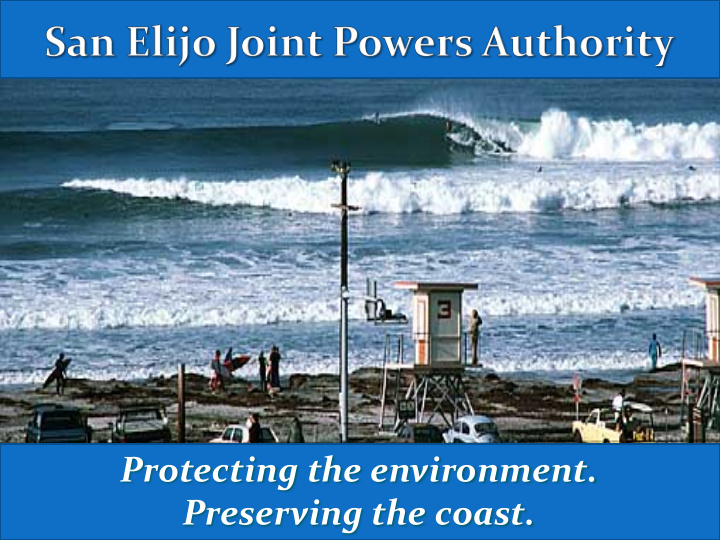



Protecting the environment. Preserving the coast.
SAN ELIJO JOINT POWERS AUTHORITY Recycled Water Program Advanced Water Treatment Michael T. Thornton, P.E. General Manager 2
Who We Are… Wastewater Service Area San Elijo JPA Member Agencies City of Encinitas City of Solana Beach Board of Directors Chair Tom Campbell Vice-Chair Mark Muir Teresa Barth David Zito 3
What We Do… Vision - “We pursue innovative practices to produce clean water in an environmentally, socially, and fiscally responsible manner." 4
A History of Coastal Stewardship Until the early 1950’s, sewage was discharged into the lagoon and coastal waters for Cardiff and Solana Beach. San Elijo Water Pollution Control Facility was built in 1965 in response to water pollution in the San Elijo Lagoon.
Serving Today, Planning for Tomorrow. Moving beyond wastewater treatment & disposal paradigm; the San Elijo JPA is focusing on maximizing recycling.
RECYCLED WATER PROGRAM Produces approx. 1350 AFY Operated in Partnership with other local districts and cities San Dieguito Water District Santa Fe Irrigation District Olivenhain Municipal Water District City of Del Mar Reduces Ocean Discharge by 40% Strong Community Support 7
San Elijo Water Reclamation Facility Recycled Water Monthly Demands Acre – Feet/Month 350 300 250 200 Ocean Discharge Recycled 150 100 50 0 jan feb mar apr may jun jul aug sep oct nov dec
RECYCLED WATER SERVICE AREA 9
RECYCLED WATER SERVICE AREA Customer Include: Del Mar Fairgrounds Golf Courses Caltrans Schools Parks Business Parks HOAs 10
RECYCLED WATER SERVICE AREA Potential New Markets 11
PROGRAM CHALLENGES Maintain Financial Sustainability Develop & Grow the Program Maintain Excellent Water Quality
TOTAL DISSOLVED SOLIDS (TDS) Measurement of dissolved salts and minerals (e.g. calcium, magnesium, sulfate, chloride, sodium, etc.) in the water.
TOTAL DISSOLVED SOLIDS (TDS) Measurement of dissolved salts and minerals (e.g. calcium, magnesium, sulfate, chloride, sodium, etc.) in the water. Not a risk to human health Most plants have a limited tolerance Can impact some industrial processes Can limit the use of recycled water
ADVANCED WATER TREATMENT (AWT) Treatment System Microfiltration (PALL ) Reverse Osmosis 15
ADVANCED WATER TREATMENT (AWT) Treatment System Microfiltration (PALL ) Reverse Osmosis AWT parallels existing recycled water sand filtration system New RW capacity = 3.0 MGD (expandable to 3.5 MGD) 16
ADVANCED WATER TREATMENT Build Footprint: ~5,000 sq ft System Startup: April 2013 Cost: $5 million Grant: $850,000 17
THE PROJECT Existing RW Treatment Train Wastewater DynaSand Chlorine Treatment Filtration Disinfection 18
THE PROJECT Existing RW Treatment Train Wastewater DynaSand Chlorine Treatment Filtration Disinfection AWT Filtration New RW Treatment Train 19
THE PROJECT Existing RW Treatment Train Wastewater DynaSand Chlorine Treatment Filtration Disinfection Design provides: AWT Operational flexibility Filtration Cost effective (E&C) Expandability New RW Treatment Train New Opportunities 20
THE PROJECT Existing RW Treatment Train Wastewater DynaSand Chlorine Treatment Filtration Disinfection Design provides: AWT Operational flexibility IPR Filtration Cost effective (E&C) Expandability Future Opportunities? New Opportunities 21
Better Wastewater = Better Recycled Water Addition of an Anaerobic Selector in the Activated Sludge Bioreactor has removed P from an average of 4.8 mg/l to less than 0.5 mg/l 22
IMPROVING COST EFFECTIVENESS Wastewater treatment process was improved to produce “best water quality” for membrane filtration. RESULTS: Low turbidity/more filterable water Reduced levels of orthophosphate (reduces scaling) Reduced chemical and energy use in secondary treatment process Improved treatment process stability (reduced variance in treated water quality) 23
Significant Power Savings Realized Power Usage (kWh) w/o Recycled Water 210,000 190,000 Power Usage (kWh) 170,000 2005 150,000 130,000 2009 110,000 90,000 Month
Significant Power Savings Realized Power Usage (kWh) w/o Recycled Water 210,000 190,000 Power Usage (kWh) 2005 170,000 150,000 2009 130,000 2010 110,000 90,000 Month
Significant Power Savings Realized Power Usage (kWh) w/o Recycled Water 210,000 190,000 Power Usage (kWh) 2005 170,000 2009 150,000 2010 130,000 110,000 2011 90,000 Month
Significant Power Savings Realized Power Usage (kWh) w/o Recycled Water 210,000 190,000 Power Usage (kWh) 2005 170,000 2009 150,000 2010 130,000 2011 110,000 2012 90,000 Month Current cost of biological treatment: 45.6 kW/MG (61 hp/MG) $109/MG, $107/acre-ft
Maximizing Treatment Performance: Temperature for SRT Target Partial Nitrification SRT ( days ) Mixed Liquor Temp (F)
Seasonal Treatment Performance Monthly Avg Secondary Effluent Turbidity (NTU) Target SRT ~ 1.5 days in summer Target SRT ~ 2.5 days in winter Month
Secondary Effluent Improvements Monthly Avg Secondary Effluent Turbidity (NTU) *Implemented SRT based on temperature May 2011 Month
PHOSPHOROUS REMOVAL Anaerobic Selector resulted in biological removal of phosphorous. Reduces: Chemicals & labor associated w/filter cleaning. 31
Treatment Optimization Results – Better Treatment - Lower Cost Energy use reduced by ~800,000 kWh annually (or 40% reduction to achieve 61 HP/MG) Well flocculated biology - no need for chemical addition to control settling (no polymer or NaOCl) Temperature adjusted SRT produces consistent effluent quality without nitrifying Significant improvements to water quality reduces the need for chemicals for filtration Provides bio-P removal at low SRT 32
MAXIMIZING COMMUNITY BENEFITS AWT provides the ability to do more than just produce “really clean” recycled water. New opportunity to strategically capture and treat urban runoff Urban Runoff is one of the leading reasons for Beach and Lagoon pollution. Impacts the City’s storm water permit compliance Collaborated with the cities on a solution that leverages the treatment capacity of the proposed AWT. 33
URBAN RUNOFF TREATMENT San Elijo Water Reclamation Facility
URBAN RUNOFF TREATMENT Storm Water System
URBAN RUNOFF TREATMENT
URBAN RUNOFF TREATMENT Construct diversion systems Use existing sewer system Treat at the SEWRF Protect coast waters New water to recycle
PROJECT PROGRESS Design Completed (Kennedy/Jenks) Peer Review (Trussell Technology) Financial Feasibility Analysis (GDH) CEQA documentation completed (DUDEK) Grant funding awarded Project financing secured Construction Initiated 38
SAN ELIJO JOINT POWERS AUTHORITY Questions Wastewater, storm water, recycled water… Providing Clean Water for the Future. 39
Recommend
More recommend